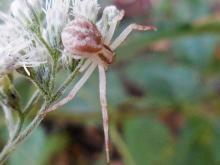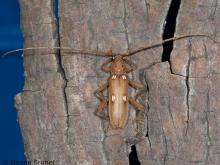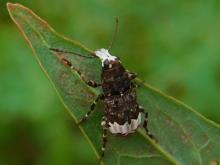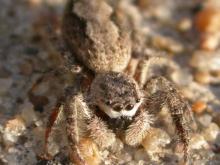Land Invertebrates
Media

Species Types
Scientific Name
Mecaphesa asperata
Description
The northern crab spider has many spiny hairs covering the top surfaces of the carapace, abdomen, and legs, and it has usually has greenish-yellow or yellow-brown markings.
Media

Species Types
Scientific Name
Mecaphesa celer (formerly Misumenops celer)
Description
The swift crab spider has many spiny hairs covering the top of its body and legs, and it often has a light pinkish-tan cast.
Media

Species Types
Scientific Name
Misumessus oblongus (formerly Misumenops oblonga)
Description
The green crab spider has spines, and the entire body and legs are pale green to silvery white. Like other crab spiders, its legs extend outward from the sides, and it can walk in any direction.
Media

Species Types
Scientific Name
Acanthoderes quadrigibba
Description
The four-humped flat-faced longhorn has no true common name, but its markings are distinctive. It plays an important role in breaking down rotten wood and enriching soils.
Media

Species Types
Scientific Name
Eburia quadrigeminata
Description
The ivory-marked beetle is a longhorned beetle whose larvae bore deep into the heartwood of a variety of deciduous trees, including oak, hickory, maple, cherry, ash, elm, and more. It can live for 40 years.
Media

Species Types
Scientific Name
About 120 species in North America north of Mexico
Description
Fungus weevils are a family of beetles that differ from other weevils by their broad, flat bills and clubbed, but not elbowed, antennae. It's a diverse group, but many do feed on bracket mushrooms and other fungi.
Media

Species Types
Scientific Name
About 175 species in North America
Description
Earthworms are familiar to just about everyone who digs in the soil. They play a major role in the nutrient cycling and structure of soils. There are many species. The most familiar ones in Missouri are nonnative.
Media

Species Types
Scientific Name
About 1,700 species in North America north of Mexico
Description
The scarab beetle family is very large, with breathtaking variety — and often great beauty. Many scarabs are large and colorful.
Media

Species Types
Scientific Name
Platycriptus undatus
Description
The tan jumping spider usually lives on tree trunks. Its gray, tan, and brown coloration camouflages it against tree bark. There is usually an undulating pattern on the abdomen.
See Also



Media

Species Types
Scientific Name
Cisseps fulvicollis
Description
The yellow-collared scape moth is more often “orange-collared.” And whether you think it looks more like a firefly or a wasp, it’s still a moth!
Media

Species Types
Scientific Name
Nearly 150 species in North America north of Mexico
Description
Slim, delicate plume moths are instantly recognizable by their T-shaped silhouette, long legs, and muted shades of tan and brown. It can be hard to separate the various species.
Media

Species Types
Scientific Name
Pyrrharctia isabella
Description
Not many people know the adult Isabella tiger moth when they see one, but we’re all acquainted with its caterpillar, the woolly worm, or woolly bear.
About Land Invertebrates in Missouri
Invertebrates are animals without backbones, including earthworms, slugs, snails, and arthropods. Arthropods—invertebrates with “jointed legs” — are a group of invertebrates that includes crayfish, shrimp, millipedes, centipedes, mites, spiders, and insects. There may be as many as 10 million species of insects alive on earth today, and they probably constitute more than 90 percent all animal species.





















